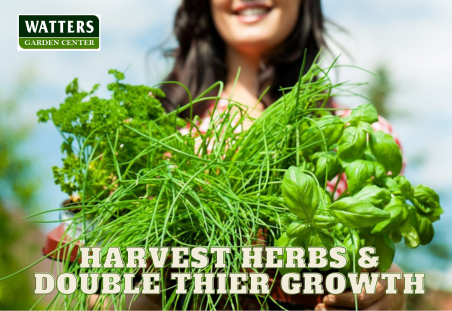By Lisa Watters-Lain, Arizona’s Garden Gal
Flavorful herbs are some of the easiest garden plants to grow, but you want to pay attention to your herb garden. Once in the ground, herbs are quickly ready for harvesting, unlike most other vegetables, which need time to ripen and mature.
The key to keeping herbs growing is to harvest often, even if you don’t need more. Herbal leaves are popular in cooking. Cutting them back throughout the growing season encourages healthy new growth and an attractive shape and keeps them producing.
When to Harvest Herbs
When it comes to herbs, harvesting equals pruning. It is often done to encourage growth, especially with fast-growing annual herbs like basil, dill, and cilantro. Snipping new growth causes these plants to branch and produce even more foliage. The same applies to slower-growing perennial herbs like thyme, sage, and rosemary. There are several good practices to consider when choosing the best time to harvest.
Annual vs. Perennial
Just because an herb is an annual plant doesn’t mean you must take the entire herb to harvest the leaves. In fact, you should never remove a whole, healthy plant until the final harvest, right before a killing frost. Pinching or snipping stems and leaves stimulates the growth of more branches and leaves. As soon as annual herbs are mature enough to withstand a bit of cutting, it’s time to begin pruning for shape and harvesting the foliage you remove. Your first harvest may be small, but if you’re consistent you will fill a basket before the season ends.
Perennial herbs tend to develop woody stems as they mature. Harvest the plants’ tender new foliage, avoiding the woody parts. Begin harvesting taller stems when they leaf out two to three inches.
Chive insider: Harvest chives by cutting leaves at the base. This is one herb that won’t branch out. A chive is a bulb that multiplies rapidly beneath the soil. Snip leaves low and to the outside of the plant, leaving the center intact.
Tip: Harvest herbs when they are dry. They are rich in essential oils and are most fragrant between mid-morning and early afternoon. Cutting wet foliage results in the loss of flavor and texture and can promote fungal diseases and rot.
Harvesting Stems with Leaves
Edible herbs harvested for their leaves include annuals and perennials like basil, oregano, sage, thyme, rosemary, dill, tarragon, savory, cilantro chives, parsley, and mint.
Choose a Stem
- Look for stems with several sets of lush green leaves and green stems.
- Choosing a branch from anywhere on the plant is okay if you take at most one-third of the entire plant at any cutting.
- You are also pruning for growth, so consider how you want to shape the herb for the most pleasing look.
Cut or Pinch Above a Node
- Using snippers, make a slightly angled cut about one-quarter of an inch above a leaf node.
- Use your thumb and index finger to pinch tender stems and remove unwanted buds and flowers.
- Don’t panic if you see a flower. As long as it hasn’t gone to seed, the stem will continue to grow. Harvest stems and dispose of the flower or pinch off just the flower.
Harvest for Shape
- Herbs grow fast! Continue harvesting leaves and stems until your plant has an even look with a nicely rounded shape.
- Check on your herbs (every few days is ideal).
End-of-Season Harvesting
- Harvest the entire annual herb at the end of the growing season or before the first frost. The plant can be pulled up with roots, or you can cut it down to ground level. Although some annual herbs reseed readily, none regrow from the same root the next year.
- Perennial herbs can benefit from a hard pruning of two-thirds of the plant after the first frost or in early spring. This is the time to cut back woody parts to reshape the plant.
Look for my other herbal columns:
Top 7 Herbs and How to Dry Them
Top 10 Herbs for Your Kitchen Garden
Until next issue, I’ll be helping gardeners grow better herbs here at Watters Garden Center.
Lisa Watters-Lain can be found throughout the week at Watters Garden Center, 1815 Iron Springs Rd. in Prescott, or contacted through her websites at WattersGardenCenter.com or Top10Herbs.com.

